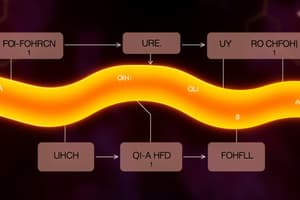Podcast
Questions and Answers
What is the primary purpose of the urea cycle?
What is the primary purpose of the urea cycle?
- To synthesize amino acids
- To produce ATP
- To convert toxic ammonia into urea (correct)
- To break down fatty acids
The urea cycle occurs exclusively in the mitochondria.
The urea cycle occurs exclusively in the mitochondria.
False (B)
Which molecule acts as the allosteric activator of Carbamoyl phosphate synthetase I (CPS I)?
Which molecule acts as the allosteric activator of Carbamoyl phosphate synthetase I (CPS I)?
N-Acetylglutamate (NAG)
The enzyme that converts arginine to urea and ornithine is called ______.
The enzyme that converts arginine to urea and ornithine is called ______.
Match the following molecules with their roles in the urea cycle:
Match the following molecules with their roles in the urea cycle:
Which molecule provides the second nitrogen atom required for the urea molecule during the urea cycle?
Which molecule provides the second nitrogen atom required for the urea molecule during the urea cycle?
Fumarate, produced during the urea cycle, directly inhibits the TCA cycle.
Fumarate, produced during the urea cycle, directly inhibits the TCA cycle.
How many ATP molecules are consumed in one turn of the urea cycle?
How many ATP molecules are consumed in one turn of the urea cycle?
The enzyme that converts Carbamoyl phosphate and Ornithine into Citrulline is ______.
The enzyme that converts Carbamoyl phosphate and Ornithine into Citrulline is ______.
What molecule stimulates the synthesis of N-Acetylglutamate (NAG)?
What molecule stimulates the synthesis of N-Acetylglutamate (NAG)?
In which cellular compartments do the various steps of the urea cycle take place?
In which cellular compartments do the various steps of the urea cycle take place?
The formation of carbamoyl phosphate requires 1 molecule of ATP.
The formation of carbamoyl phosphate requires 1 molecule of ATP.
What molecule is regenerated in the final step of the urea cycle, allowing the cycle to continue?
What molecule is regenerated in the final step of the urea cycle, allowing the cycle to continue?
The enzyme that catalyzes the conversion of citrulline to argininosuccinate in the cytoplasm is called ______.
The enzyme that catalyzes the conversion of citrulline to argininosuccinate in the cytoplasm is called ______.
Match the following urea cycle molecules with their origin or destination:
Match the following urea cycle molecules with their origin or destination:
Which molecule directly links the urea cycle and the TCA cycle?
Which molecule directly links the urea cycle and the TCA cycle?
N-Acetylglutamate (NAG) inhibits Carbamoyl phosphate synthetase I (CPS I).
N-Acetylglutamate (NAG) inhibits Carbamoyl phosphate synthetase I (CPS I).
What are the two nitrogen-containing molecules incorporated into the urea molecule during the cycle?
What are the two nitrogen-containing molecules incorporated into the urea molecule during the cycle?
The synthesis of N-Acetylglutamate is stimulated by the presence of ______.
The synthesis of N-Acetylglutamate is stimulated by the presence of ______.
What is the direct product of the reaction catalyzed by argininosuccinate lyase?
What is the direct product of the reaction catalyzed by argininosuccinate lyase?
Which of these molecules is NOT directly involved in the formation of carbamoyl phosphate?
Which of these molecules is NOT directly involved in the formation of carbamoyl phosphate?
The conversion of citrulline to argininosuccinate occurs in the mitochondria.
The conversion of citrulline to argininosuccinate occurs in the mitochondria.
What is the function of the molecule ornithine within the urea cycle?
What is the function of the molecule ornithine within the urea cycle?
The urea cycle eliminates excess ______ from amino acid metabolism.
The urea cycle eliminates excess ______ from amino acid metabolism.
Match the following enzymes with their respective reactions in the urea cycle:
Match the following enzymes with their respective reactions in the urea cycle:
What is the direct fate of fumarate produced during the urea cycle?
What is the direct fate of fumarate produced during the urea cycle?
Arginine directly activates Arginase in the urea cycle.
Arginine directly activates Arginase in the urea cycle.
What is the immediate precursor of urea within the urea cycle?
What is the immediate precursor of urea within the urea cycle?
Increased amino acid catabolism leads to higher levels of ______, which in turn increases the activity of the urea cycle.
Increased amino acid catabolism leads to higher levels of ______, which in turn increases the activity of the urea cycle.
Match the following molecules of the urea cycle with their location of reaction:
Match the following molecules of the urea cycle with their location of reaction:
Which of these molecules is a substrate for the enzyme ornithine transcarbamoylase (OTC)?
Which of these molecules is a substrate for the enzyme ornithine transcarbamoylase (OTC)?
The enzyme arginase converts argininosuccinate into arginine and fumarate.
The enzyme arginase converts argininosuccinate into arginine and fumarate.
What molecule is the end product of the urea cycle, and is excreted in urine?
What molecule is the end product of the urea cycle, and is excreted in urine?
The synthesis of N-Acetylglutamate (NAG) is stimulated by the presence of the amino acid ________.
The synthesis of N-Acetylglutamate (NAG) is stimulated by the presence of the amino acid ________.
Match the following molecules with their location in the urea cycle:
Match the following molecules with their location in the urea cycle:
Which molecule directly provides a link to the TCA cycle?
Which molecule directly provides a link to the TCA cycle?
The urea cycle requires 2 ATP molecules during the formation of carbamoyl phosphate.
The urea cycle requires 2 ATP molecules during the formation of carbamoyl phosphate.
What is the role of ornithine in the urea cycle?
What is the role of ornithine in the urea cycle?
The enzyme, __________, converts arginine to urea and ornithine.
The enzyme, __________, converts arginine to urea and ornithine.
Match the enzymes with their respective substrates in the urea cycle:
Match the enzymes with their respective substrates in the urea cycle:
Flashcards
Urea Cycle
Urea Cycle
A metabolic cycle that takes place in the liver to convert toxic ammonia into urea, which is then excreted in urine.
Urea
Urea
A nitrogenous waste product produced by the urea cycle, safely excreted in urine.
Formation of Carbamoyl Phosphate
Formation of Carbamoyl Phosphate
The first step of the urea cycle occurs in the mitochondria, where ammonia is converted into carbamoyl phosphate.
Carbamoyl Phosphate Synthetase I (CPS I)
Carbamoyl Phosphate Synthetase I (CPS I)
Signup and view all the flashcards
N-Acetylglutamate (NAG)
N-Acetylglutamate (NAG)
Signup and view all the flashcards
Formation of Citrulline
Formation of Citrulline
Signup and view all the flashcards
Ornithine Transcarbamoylase (OTC)
Ornithine Transcarbamoylase (OTC)
Signup and view all the flashcards
Citrulline
Citrulline
Signup and view all the flashcards
Formation of Argininosuccinate
Formation of Argininosuccinate
Signup and view all the flashcards
Argininosuccinate Synthetase
Argininosuccinate Synthetase
Signup and view all the flashcards
What is the purpose of the urea cycle?
What is the purpose of the urea cycle?
Signup and view all the flashcards
How is carbamoyl phosphate formed in the urea cycle?
How is carbamoyl phosphate formed in the urea cycle?
Signup and view all the flashcards
What happens during the formation of citrulline in the urea cycle?
What happens during the formation of citrulline in the urea cycle?
Signup and view all the flashcards
How is argininosuccinate formed in the urea cycle?
How is argininosuccinate formed in the urea cycle?
Signup and view all the flashcards
What happens during the formation of arginine in the urea cycle?
What happens during the formation of arginine in the urea cycle?
Signup and view all the flashcards
How is urea formed and how is the cycle restarted?
How is urea formed and how is the cycle restarted?
Signup and view all the flashcards
What is the role of N-acetylglutamate (NAG) in the urea cycle?
What is the role of N-acetylglutamate (NAG) in the urea cycle?
Signup and view all the flashcards
How does the urea cycle respond to increased amino acid catabolism?
How does the urea cycle respond to increased amino acid catabolism?
Signup and view all the flashcards
What is the role of ornithine in the urea cycle?
What is the role of ornithine in the urea cycle?
Signup and view all the flashcards
What is the role of aspartate in the urea cycle?
What is the role of aspartate in the urea cycle?
Signup and view all the flashcards
What role does N-acetylglutamate (NAG) play in the urea cycle?
What role does N-acetylglutamate (NAG) play in the urea cycle?
Signup and view all the flashcards
How is citrulline formed in the urea cycle?
How is citrulline formed in the urea cycle?
Signup and view all the flashcards
How is carbamoyl phosphate formed?
How is carbamoyl phosphate formed?
Signup and view all the flashcards
What is the role of N-acetylglutamate (NAG)?
What is the role of N-acetylglutamate (NAG)?
Signup and view all the flashcards
How is citrulline formed?
How is citrulline formed?
Signup and view all the flashcards
How is argininosuccinate formed?
How is argininosuccinate formed?
Signup and view all the flashcards
What happens during the formation of arginine?
What happens during the formation of arginine?
Signup and view all the flashcards
How is urea formed and the cycle restarted?
How is urea formed and the cycle restarted?
Signup and view all the flashcards
Study Notes
Urea Cycle Overview
- The urea cycle occurs in the liver, converting toxic ammonia (NH₃) into urea, which is excreted in urine.
- This cycle eliminates excess nitrogen from amino acid metabolism.
- The process involves reactions in both the mitochondria and the cytoplasm.
Steps of the Urea Cycle
Formation of Carbamoyl Phosphate (Mitochondria)
- Enzyme: Carbamoyl phosphate synthetase I (CPS I)
- Reaction: Ammonia (NH₃) + Bicarbonate (HCO₃⁻) + 2 ATP → Carbamoyl phosphate
- Activator: N-Acetylglutamate (NAG)
Formation of Citrulline (Mitochondria)
- Enzyme: Ornithine transcarbamoylase (OTC)
- Reaction: Carbamoyl phosphate + Ornithine → Citrulline
- Citrulline is transported to the cytoplasm.
Formation of Argininosuccinate (Cytoplasm)
- Enzyme: Argininosuccinate synthetase
- Reaction: Citrulline + Aspartate + ATP → Argininosuccinate
- Aspartate provides the second nitrogen for urea.
Formation of Arginine (Cytoplasm)
- Enzyme: Argininosuccinate lyase
- Reaction: Argininosuccinate → Arginine + Fumarate
- Fumarate enters the TCA cycle, linking the urea and TCA cycles.
Formation of Urea and Regeneration of Ornithine (Cytoplasm)
- Enzyme: Arginase
- Reaction: Arginine → Urea + Ornithine
- Ornithine is transported back to the mitochondria, initiating the next cycle.
Key Molecules and Their Roles
- Ornithine: A carrier molecule, regenerated to continue the cycle.
- Aspartate: Provides the second nitrogen needed for urea synthesis.
- ATP: 3 ATP molecules are consumed per cycle.
- Urea: The end product of the cycle, excreted in urine.
- Fumarate: An intermediate product linking the urea and TCA cycles.
Regulation of the Urea Cycle
Activation of CPS I
- N-Acetylglutamate (NAG): An allosteric activator of CPS I.
- NAG synthesis is stimulated by arginine, ensuring the cycle functions efficiently when nitrogen levels are high.
- Substrate availability: Increased amino acid catabolism leads to more ammonia, increasing cycle activity.
Studying That Suits You
Use AI to generate personalized quizzes and flashcards to suit your learning preferences.




